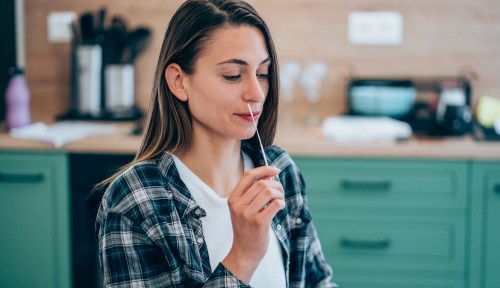Positive COVID-19 Self-Test? An Epidemiologist Shares 3 Things To Do ASAP
What do the moment you end up with a positive COVID-19 self-test, according to an epidemiologist and government officials.

If you want to figure out your COVID-19 status in the comfort of your own home, self-tests—available at your neighborhood drugstore—are a solid option. The Food and Drug Administration (FDA) approved the first at-home COVID-19 self-test back in November 2020, and a series of authorized tests followed shortly thereafter. As convenient as they are, however, these tests put the onus on you to let your doctor know if you receive a positive result and to follow the necessary health and safety protocols.
Experts in This Article
a University of California, Irvine professor of Epidemiology &
“The advantage of at-home tests is that they are fast,” says Karen Edwards, PhD, a professor and chair of the department of epidemiology at the University of California, Irvine. “You get the results immediately, in 10 to 15 minutes, for example.” This type of test is particularly useful if you’ve just learned you were exposed to COVID-19, or if you want to double-check that you’re in good health before seeing friends and family.
Still, there are a few disadvantages to taking at-home tests, Dr. Edwards says. At-home antigen tests work by detecting a specific antigen, or a substance that prompts your body to produce antibodies that fight COVID-19. Antigen tests have an overall sensitivity of about 85 percent or less (meaning, they miss at least 15 percent of positive cases). Meanwhile, the polymerase chain reaction (PCR) tests you get at the doctor’s office or pharmacy work by detecting genetic material from the virus and are “highly sensitive” to detecting it. “The at-home test kits are generally pretty good, but their accuracy is not necessarily as high as the PCR-based tests,” Dr. Edwards says.
That said, at-home antigen tests are unlikely to deliver false positives, but they may deliver a false negative if you take one too early. “If you have a positive test, it’s generally pretty likely that that test really is positive. The false positive rate is low. Now, the opposite of that is that there can be false negatives,” says Dr. Edwards. Remember: at-home tests are looking for antigens, so if your body hasn’t started producing them yet, the test may serve you an inaccurate result. And thus, it’s always best to take a second test the next day—especially if your symptoms continue.
To help you navigate the brave new world of at-home COVID-19 tests in the most socially-conscious way possible, we asked Dr. Edwards what to do if you test positive for COVID-19 at home. Below, she talks about why telling your doctor is critical to understanding and fighting SARS-CoV-2 (the virus that causes COVID-19). Plus, how to practice health and safety protocols the moment you test positive.
3 things to do if you have a positive COVID-19 self-test, according to an epidemiologist
1. Tell your doctor or healthcare provider you tested positive and ask them how to report your result
The Center for Diseases Control and Prevention (CDC) says, “If your COVID-19 test is positive, tell a healthcare provider about your positive result and stay in contact with them during your illness.” That way, your doctor can offer their best advice for self-isolating and taking care of yourself while you’re sick. Plus, if your symptoms become more severe, they can bring you in for another test and assess the necessary next steps.
Your doctor also may be able to offer specific guidelines for reporting your COVID-19 test result to local contact tracing officials, or to other organizations that may gather COVID-19-data to inform infection rates, public health policy, and more. While COVID testing sites and labs are required to report their findings, the at-home tests are not—and this poses an issue.
“Being able to monitor what’s happening in communities and regions helps inform policy and public health actions in those local areas. It also helps us think about how COVID-19 is spreading,” says Dr. Edwards. So if you do test positive, your doctor may be able to help you do your part in closing the data gap.
2. Stay at home and follow all COVID-19 requirements
“For me, the benefit of these in-home test is convenience,” says Dr. Edwards. “As soon as people start having symptoms, they can take a test. And if they test positive, they can isolate themselves from other individuals and try to reduce the spread that way. We rely on people’s good behavior.” According to the CDC, this “good behavior” includes isolating for 10 full days, wearing a mask if you could potentially come into contact with others, and avoiding indoor gatherings until the virus has run its course. Spending 10 days alone isn’t exactly fun, but it’s the best way to ensure you’re taking care of your loved ones and community.
3. Call anyone you may have come in contact with
The CDC also notes that you should call anyone you’ve encountered recently to ask them to get tested. “A person with COVID-19 can begin spreading it starting 48 hours (or two days) before the person has any symptoms or tests positive,” says the CDC. “By informing your close contacts they may have been exposed, you are helping to protect everyone.”
Oh hi! You look like someone who loves free workouts, discounts for cutting-edge wellness brands, and exclusive Well+Good content. Sign up for Well+, our online community of wellness insiders, and unlock your rewards instantly.
Sign Up for Our Daily Newsletter
Get all the latest in wellness, trends, food, fitness, beauty, and more delivered right to your inbox.
Got it, you've been added to our email list.










